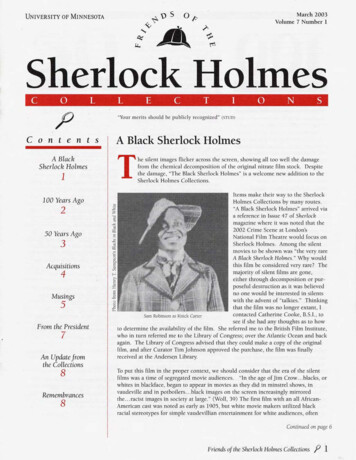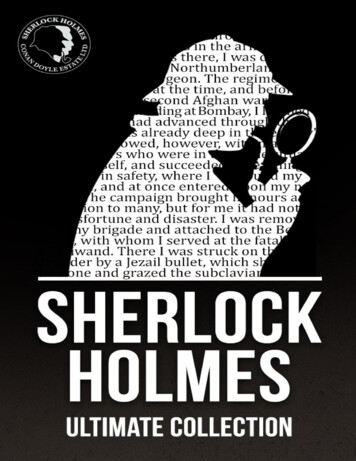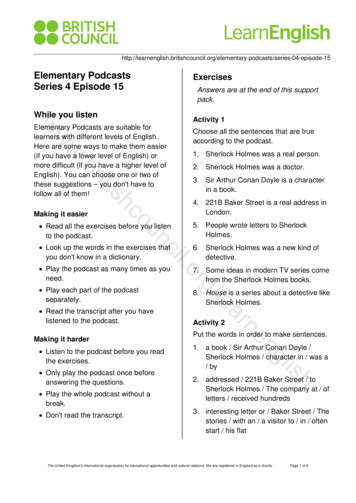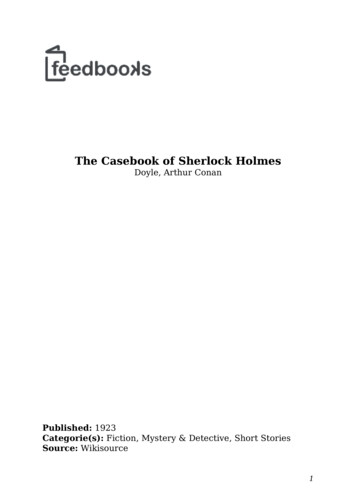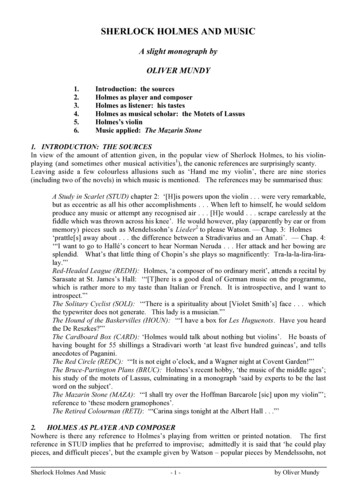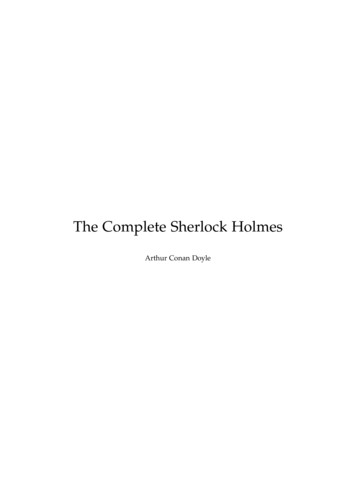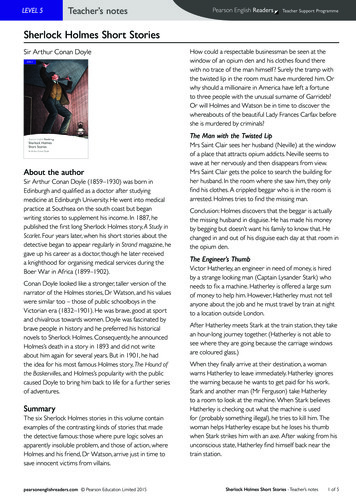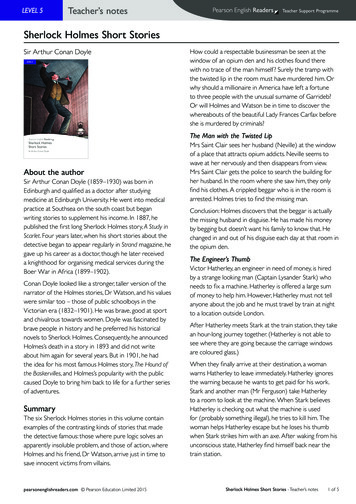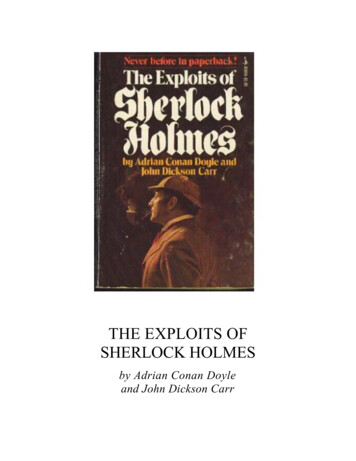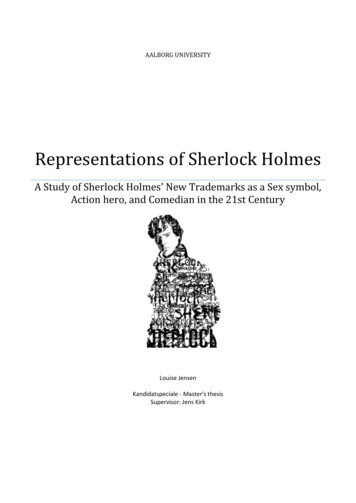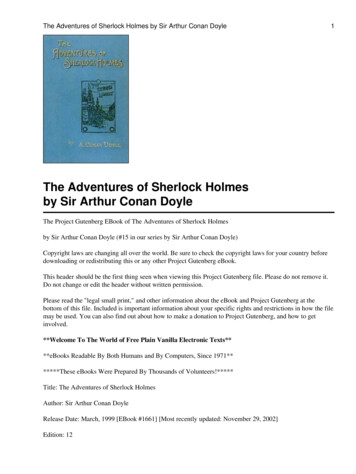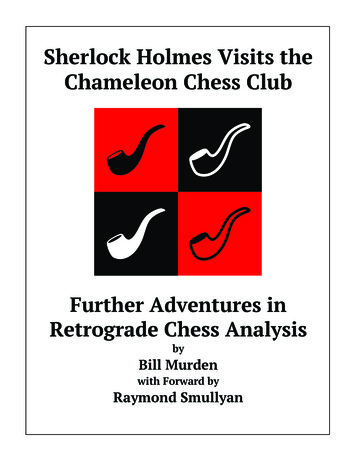
Transcription
Sherlock Holmes Visits theChameleon Chess ClubFurther Adventures inRetrograde Chess AnalysisbyBill Murdenwith Forward byRaymond Smullyan
THIS IS A DESKTOP BOOK PUBLISHING BOOKPUBLISHED BY WILLIAM F. MURDENNot copyrighted. Author encourages wide dissemination, in whole or in part.Publishing History First Edition (4 paper copies) September 1995Contained 75 problems. Second Edition (2 paper copies) December 1995Reduced to 70 problems. Text substantially modified.Basis for Raymond Smullyan’s review. Third Edition (4 paper copies) June 1996Revised to satisfy Smullyan’s critique and to include his Foreward.Submitted to Smullyan’s publisher, who required 42 months to realize that “We don’tpublish this kind of material except for Raymond Smullyan.” Author was then (April2000) 76 years old and could not tolerate further such delays, so chose to self-publish aFirst Distribution. First Distribution (50 paper copies) May 2000Only minor changes from the Third Edition. Second Distribution (digital edition) May 2017No changes in text from First Distribution. Added table of contents and problem index.Prepared by Fred Stahl, a long-time friend and professional colleague of the late BillMurden, to bring his brilliant work to a wider audience. fred@fredstahl.com
TABLE OF CONTENTSForeword by Raymond Smullyan .iAuthor’s Preface . ii–vIntroductory Problems . 1–6Problems 2–70 . 7–144Solutions 1–70. 145–223Appendix – Refresher on Fundamental Methods of Retrograde Analysis . a1–a9About the Author . Last Page
iFORWARDThis is a marvelous book of chess problems in what is known as retrograde analysis inwhich the solutions involve deducing what must have taken place in the past of the game.These intriguing problems have much the flavor of detective stories. This present volumeis a perfect sequel to my Chess Mysteries of Sherlock Holmes and Chess Mysteries of theArabian Knights; I cannot imagine a better one! Although the author calls it a “sequel,”it can be read independently of my two volumes, since enough introductory material hasbeen provided.In this fascinating book, the author has definitely broken new ground. He has variedand advanced many of my themes of retrograde analysis to a remarkable degree. Forexample, as complementary to my monochromatic problems, in which no piece evermoves from a square of one color to a square of a different color, the author hasintroduced heterochromatic problems, in which it is given that on each move, the piecealways goes from a square of one color to a square of a different color. This opens up anentirely new field of beautifully elaborate combinatorial situations. As another example,the author has cleverly combined some of his retrograde chess problems with my knight/knave (truth-teller, liar) logic puzzles.The problems are really dazzling in their ingenuity, and I am delighted that retrogradeanalysis has taken such an unexpectedly imaginative and creative turn.Raymond SmullyanElka Park, New York
iiAUTHOR’S PREFACEA reader to whom “further” in the subtitle is meaningful would expect the author to beRaymond Smullyan. He is the logician who introduced puzzle afficionados to retrogradechess analysis. And he used Sherlock Holmes as the analyst par excellence, with Watsonas his student and scribe. Smullyan’s 1979 book, Chess Mysteries of Sherlock Holmes,justifiably ranks as a classic. The present book could look suspiciously like anunauthorized sequel. (Smullyan’s Chess Mysteries of the Arabian Knights was a secondbook of retrograde analysis problems, but not truly a sequel to the first.) The presentbook even makes use of some of Smullyan’s peripheral characters, specifically Lord andLady Ashley.I would not dream of presenting a book on retrograde chess analysis withoutacknowledging that it builds on Smullyan’s pioneering publication. Much of the presentcontent enlarges on or contrasts with Smullyan’s foundations, and continuity betweenthose foundations and the extensions is important. This is a separately authored sequel,but Raymond Smullyan has had an opportunity to preview it and, in the Forward, hasexpressed his acceptance of its appearance as sequel. Since this book stands onfoundations fashioned by Smullyan, he is entitled to share in any kudos, while remainingfree from blame for defects in any of its details.That 1979 Smullyan work had a whole new world to explore. Smullyan ranged overthe constraints, inherent in chess, that permitted some courses of play to be eliminated aslogical impossibilities, with what was left necessarily true. He preempted the elegantlysimple principles so completely that any follow-on volume is forced to emphasize morecomplex problems.For the previously uninitiated reader, retrograde chess analysis attempts to answerquestions about the history of a specific game. In the purest form, a diagram shows thepresent position, and a question is asked, such as:What was the last move?What piece was captured on square f5?Was the missing Knight captured on the 18th or 19th move of the game?Can Black castle? (Is it Black's move? Is he in check? Have his King and oneRook remained unmoved?)Even Smullyan found it necessary to introduce additional constraints to arrive at fiftyproblems with fresh elements. He proposed the “monochromatic” game in which everymove is between two squares of the same color. He set some problems on boards ofambiguous square colors, bringing move direction into the set of unknowns; one problemadded chess pieces of ambiguous colors. A few of his players used what Smullyandescribed as ancient rules of chess, permitting a promoting Pawn to be exchanged for apiece of either color.The physical awkwardness of his players gave Smullyan much ammunition. A frequentsituation was a jostled board, with one or more pieces displaced from square centers and
iiiambiguously straddling lines between squares, or even corners that extended theuncertainty to four squares. Occasionally a piece would be knocked completely from theboard and be replaced with a coin or other marker, leaving passersby to wonder at pieceidentity and/or color.Finally, comments by players or observers may add to the information given by thechess position alone:White gave odds of the Queen’s Bishop.Black castled four moves ago.Pawns made all captures.Such supplementary information adds further constraints and greatly extends thefeasible range and richness of logical analysis.To any reader not familiar with The Chess Mysteries of Sherlock Holmes, my advice isto find a copy, and work through it while deferring the present book. You will experiencea sense of wonder, and the exhilaration of a new challenge, just as earlier readers did.And you will confront this fresh set of problems with an excellent understanding of whatretrograde chess analysis is, and how to apply the basic constraints of chess to anyproblem in the genre.**********What will you find in the present book? It contains one major, conceptually newelement -- the heterochromatic game, in which each move is between squares of oppositecolors. The unique set of constraints in that game form allows a progression reminiscentof Smullyan’s, with individual constraints allowing beautifully simple introductoryproblems. They also allow for the ready resolution of multiple ambiguities (fiveambiguities of piece color and placement appear as early as the seventh problem in thebook).The book combines several of Smullyan’s ambiguities, and mixes them with the newset. Conventional black-and-white boards signal use of conventional promotion rules.The board of ambiguous colors (chameleon board) signals player use of color-changingrules of promotion (chameleon promotion); avoiding the awkwardness of flagging therules difference at each use. Not all such problems feature actual reverse promotions, theplayer agreement serving as an artifice for introducing uncertainty of move direction.The heterochromatic game and the older monochromatic game (or the generallysimilar homochromatic form) take on new dimensions when set on the chameleon board,exercising constraints not important on the conventional board. The combinationspermit a richer problem environment. Differences in meaning between monochromaticand homochromatic are flagged after the first problem herein, and reflect agreementbetween Smullyan and the present author.Even on the conventional board, there are quantitative extensions from Smullyan’sproblems that almost amount to qualitative differences. A homochromatic game is shown
ivat an advanced stage, with no supplementary information; it is possible to identify White’sthird move uniquely! With supplements, that game form permits a detailed history of 10captures: what captured each piece, where, and in what chronological order.The en passant capture will rear its head occasionally, in contexts not explored bySmullyan.Smullyan has written many popular books of recreational logic not involving thechessboard. A few problems. herein use “truth table” logic in preludes contributing toproblem definition. One recognizes Smullyan’s What Is the Name of This Book?, twistingit into What Is the Game of This Rook?.On the average, the earlier problems are simpler than those later in the book. But thedifficulty is deliberately varied throughout. A very small number of simple problemsherein cover no ground left unexplored by Smullyan. They are included as review ofelementary principles in preparation for extending those principles to new settings.Elementary problems in move parity of a pair of Knights, for example, pave the way forthe broader applicability of move parity in problems involving multiple Knights orheterochromatic play.For the benefit of readers who are new to retrograde chess analysis, and unable tolocate the original Smullyan book(s), an Appendix treats briefly some fundamentalprinciples, such as the counting of Pawn captures.**********In problem definitions, in the absence of cautions to the contrary, all comments byplayers or observers (and by Sherlock Holmes) are taken as absolute truth. It is sometimesnecessary to filter out conversational fog to identify potentially crucial information. Andtruth must be interpreted literally; Watson often makes false assumptions about whatcomments imply, and the reader must guard against that tendency.Problem solutions, also, are presented in conversational form. That makes themlengthier than they need be, but serves two important purposes. Watson often pursuesalternative solutions that prove to be blind alleys or traps for the unwary. Some of thosealternatives could appear attractive to some readers, who would remain unconvinced ifthe analysis ignored them.More importantly, the conversational approach allows use of the Socratic methodthroughout. Holmes asks pointed questions for Watson to answer through analysis, eachquestion leading closer to the solution. That device breaks a complex problem into asequence of simpler subproblems for the less expert to pursue. A reader who doesn't knowwhere to begin may get enough of a hint from Holmes’s first or second question to carrythe analysis to completion. Problems are removed from the “Pass/Fail” category, forgreater reader satisfaction.A final note concerns position identification. Chessboards are normally described by acoordinate system in which files are lettered a to h from left to right, and ranks
vnumbered 1 to 8 from the bottom up. Thus, square c5 is in the third file from the left andfifth rank from the bottom. But ranks and files may not be obvious on the chameleonboard. For consistency herein, letters a to h identify columns from left to right, andnumbers 1 to 8 identify rows from bottom to top of the diagram.**********The chess position graphics herein clearly are computer-generated. A graphics font of42 array files represents only the six standard chess pieces plus the Unknown (questionmark), in Black and White on squares of white, horizontally striped gray, and verticallystriped gray. Unconventional effects (pieces of mixed color patterns and pieces displacedfrom square centers) are generated by program algorithms. Tailored array files forsquare borders supplement the centered-piece arrays and are drawn on automaticallywhen pieces must appear to straddle those borders. Print resolution is 180 dots per inchin each direction, equality of vertical and horizontal resolution being essential to thechameleon board. In the middle 1980's, when the print program was developed, onlyEpson printers designated ESC/P or ESC/P2 offered that equality. The author’schessprint program was tailored to and is usable with only those selected Epson printers.
PAGE NUMBERS OF PROBLEMS AND SOLUTIONSExample: the third problem, QUEENS GALORE, is on page 9. Its solution is on 146.1. CHAMELEON BOARD2. A CHAMELEON CASTLINGCONUNDRUM3. QUEENS GALORE4. HOW CAN THAT BE?5. WHITE'S LAST MOVE6. WHOSE HUE?7. FIVE TO RESOLVE8. EN PASSANT9. HOMOCHROMATIC?10. AMBIGUOUS PAWNS11. RESTING PLACES12. COUNTLESS KNIGHTS13. FALLEN QUEEN14. PLACES FOR ALL15. EACH HAS PROMOTED16. KNIGHT SITE17. WHAT IS THE QUESTION?18. WHAT FELL FROM WHERE?19. PROMOTED AND DEPARTED20. BOTH CASTLE?21. CAPTURE AND CASTLE?22. POSITIONING MOVE23. WHEN DID KNIGHT FALL?24. WHAT COLOR?25. GET THE NUMBER26. NUMBER UPPED?27. THERE IS A SOLUTION!28. CHECKING ACCOUNT29. FROM WHERE?30. THE ROAD TAKEN31. DUAL PROMOTIONS32. UNMASK THE BISHOP33. ROOK DOWN34. PROMOTED TO TRAVEL35. PAWN OR 6516616716816917017117217317336. TRUTH AT THE TABLE37. WHITE'S THIRD MOVE?38. LAST NONCASTLING MOVE?39. HOMCROMATIC PROMOTION40. UNCHANGING CHAMELEON?41. FIND THE CHECKMATE42. DÉJÀ VU AGAIN?43. TRUTH BE TOLD44. AT WHOSE HANDS?45. AN OPEN FILE46. MORE THAN ONE WAY47. ONE WITHOUT THE OTHER48. TO HIDE A HIPPOPOTAMUS49. TO RESOLVE A PAWN50. HOMOCHROMATICAMBIGUITIES51. AFTER CONSECUTIVE CASTLING52. TWO-COLOR COORDINATES53. PROMOTION ORDER54. SMATHERS RESIGNS55. CORNERED PAWN56. ON WHICH SIDE?57. FORCED FINALE58. A CASTLING MATRIX59. SHADES OF GREY60. INDETERMINATE QUEEN61. THREE CHECKING?62. CANCELLED CHECKS63. BOTH LAST MOVES64. DISPLACED TRIO65. PLAY BEFORE MATING66. TRUE COLOR67. MORIARTY'S QUESTION68. THE ROOK ON H769. TERMINAL MOVE70. BLACK'S 2Use PDF Numbers to move quickly among problems and solutions. A PDF Number is a pagenumber plus 10. Type a PDF Number in the white box in the marquee of Acrobat and hit Return.
1A NEW CHESS CLUB"Come, Watson!" cried Holmes when I answered my door. "There's a new chess clubwe must visit. Opportunities for retrograde analysis should abound there."He refused to answer my queries until we had reached the club, where a subdued signidentified it as the "Chameleon Chess Club." Clearly alerted to my friend's planned visit,the club secretary, Goodwin, greeted us effusively upon our entrance.Goodwin led us to an unoccupied table, where the position was as shown in theaccompanying figure. Rather than the usual white and black squares, this board used two1. CHAMELEON BOARD
2shades of grey, distinguished by vertical or horizontal striping."Most of our members like to play occasionally using the ancient rules of promotion,which allow a promoting Pawn to change color," said Goodwin. "Our club name derivesfrom that color-changing capability. So that passersby can know which promotion rulesare in effect, we use standard black.and.white boards for play with· normal promotionrules, and chameleon boards, as we call these, with chameleon rules of promotion.""Do your players always treat vertical greys as white squares?" asked Hoimes."Good lord, Holmes!" I ejaculated. "You have already concluded that play is up anddown rather than left and right. I didn't have the foggiest clue as to move direction.""Nor do I, Watson," replied my friend. "But notice that if the board is rotated 90degrees clockwise, what was a horizontal square at the lower left corner transforms to avertical square at the upper left corner. From the players' viewpoint, the upper leftcorner ofthisboard is a vertical grey no matter how the board is oriented. But, withoutknowing where the players sat, we don't know whether play was up. down or left.right.My question was whether all of the chameleon boards are of the same configuration. Aboard that always had a horizontal square at upper left would serve equally well."Goodwin chimed in, "All of our chameleon boards are like this one, with the upper leftsquare vertical. Players can always interpret vertical as white, horizontal as black."I inquired, "Do your players depart from modern rules of chess in other respects?""No," Goodwin replied. "We welcome observers and wish to minimize any possibilityof distressing them. If an observer understands the significance of the board choice, hecan watch any complete game and never see what he could interpret as a rules agreements.Anexampleishomochromatic play, in which every move is between two squares of. the same color. Butit is clearly understood that thelegalityof moves between squares of opposite colors is notchanged by the agreement to avoid such moves."Holmes commented, "That distinction is particularly important in the definition ofchecking. For example, Knights do not move homochromatically; but a King is stillprohibited from moving to a square where an opposing Knight w ould give check."Just then Soames-Forsyte walked up and greeted us. "I can't imagine you find thisobvious position very interesting. The game ended here. I announced mate in one move,and Galsworthy conceded.''"I note," said Holmes, "that therewasa reverse promotion."Without too much prompting, I was able to see the logic behind that conclusion. AUTHOR'S NOTE: [Solutions to this and subsequent problems appear at the back ofthe book, in the order of problem encounter, and identified by the same problemnumbers and titles used for problem diagrams.]
3THE AUTHOR PUTS HIS OAR IN: WHY HOMOCHROMATICPLAY, NOT MONOCHROMATICAs this book was being readied for publication, private communications between theauthor and Raymorut Srnullyan revealedadifference in our understandings ofmonochromatic games. Smullyan had invented and named the concept in The ChessMysteries of Sherlock Hobnes There six problems dealt with games in which no move wasbetween. two squares of opposite colors; every piece remained on its· original square colorthroughout the game. The word "monochromatic," meaning literally "one color," wasWHOSE RULES?
4applied strictly to the individual move, and by extension to games made up entirely ofsuch moves.In some of the earliest Smullyan problems, monochromatic play was reported simplyas possibly relevant historical fact, just as in another problem we might be told thatneitherKinghasmoved.In laterproblemswemeetpeoplemonochromatic games, implying deliberation and agreement.whoalwaysplayIf monochromatic play"just happened," we need not consider the possibility of rules changes. But, when playershave agreed to play only homochromatically, the details of their agreementmay needtobe brought into the open.The accompanying figure (WHOSE RULES?) can illustrate the dichotomy. Could theposition have resulted from monochromatic play? If so, since Knights cannot movemonochromatically; the White Knight on fi has to be a promoted White Pawn; provingthat White is moving down th board. The Black King originated on dl, and has traveledto a8 on white squares only. Its last move was from b7. It reached b7 from a6, or c6, ord7 through c8. The White Kni ght was on b8 when the Black King moved to a6 or c6 ord7. Wasn't that King move an illegal move into check by the Knight?Normal cm}ss rules would prohibit the indicated Black King moveasa move intocheck. Those rules apply when monochromatic play "just happens." Do they apply whenmonochromatic play is by agreement? Raymond Smullyan says they do not, and it is hisball game. Smullyan reasons that the player agreement constitutes a single change in therules of chess, accepting only monochromatic moves as legal. Check is automaticallydefined in terms of move legality. Kings are never captured, but the test of check is this:it the King were replaced by any other piece of its color, would the opposing piece be ableto capture the substituted piece? If so, the opposing piece checks the King; if not, there isno check. In agreed monochromatic play with Smullyan's interpretation, the Black Kingwould not have been in check on a6, c6, or d7, and could have reached its presentlocation legally.An alternative, favored by the present author, is to consider the player agreement asbinding up to a point, but not as changing any rules of chess. The players have merelyagreed that,so long asitprol'es possible,they will limit themselves to using a specificsubset of the legal moves, the monochromatic. moves. But the moves they avoid remainlegal; the White Knight in the illustration could legally capture on a6, c6, or d7, thuswould give check if the Black King were on one of those squares. This interpretationoffers two advantages:(1) One need not distinguish between games that just happened to be monochromaticand those that were limited by player agreement. The same rules apply in both cases.(2) An observer who was unaware of the specific player agreement could, nevertheless,watch any complete game and never see what he would interpret as an illegal move orposition (one of Goodwin's requirements in the Chameleon Chess Club).Neither of the conflicting interpretations is illogical, and neither is inconsistent withSmullyan's previously published examples of monochromatic games. Both can makecontributions to future retrograde chess analysis. But we must be able to know which
5interpretation applies in any problem context. Smullyan has suggested a solution. Weagree to reserve Smullyan's term monochromatic ("one color") for player agreementsthat are recognized as changing the rules of chess, and intrOduce the near-equivalentword homochromatic ("same color") for agreements that retain the conventional legalityof all moves while additionally restricting play to the same-color subset of legal moves.Because of the emphasi s on "observer-friendly" play in the Chameleon Chess Club,homochromatic play, but not monochromatic, is found herein. Monochromatic play as nowdefinedMnidentifiedKingsasareproduce positions far more disturbing than that above. Note the figureGOODWIN'S NIGHTMARE, where the conventional viewpoint is that rstoodGOODWIN'S NIGHTMARE·:·:·:·:·:·:·:·:·:·' ' ' ' ' ' ' ' ' ' ' ' ' ' ' ' ' ' ' '' ' ' ' ' ' ' ' ' '' ' ' ' ' ' ' ' ' ' ' ' ' ' ' ' ' ' ' ' 1 ' ' ' ' ' ' ' ' '' ' ' ' ' ' ' ' ' �:·:·:' ' ' ' ' ' ' ' ' ' , , , , , , , , , ,·:·:·:·:·:·:·:·:·:·' ' ' ' ' ' ' ' ' '·· ··· ··· · ······ ····' ' ' ' ' I ' ' ' ', , , , , , , , 1,.,' ' ' ' ' ' ' ' ' ',., , , , ,1, , ,' ! ! ! ! ! ! ! : : ! ! ! ! ! ! ! ! ! ! ! ! ! ! : ! ! ! ! ' ' ' ' ' ' ' ' ' ', , ,1, .,.,.,1, 1, ! ! ! : ! ! ! ! ! ' ' ' ' ' ' ' ' ' '' ' ' ' ' ' ' ' ' '.,.,.,t, ,····· ····' ' ' ' ' ' ' ' ' ' ' ' ' ' ' ' ' ' ' '' ' ' ' ' ' ' ' ' ' ' ' ' ' ' ' ' ' I ! : ! ! ! ! ! !:!·' ' ' ' ' ' ' ' '' ' I ' ' ' ' ' ' '' ' ' ' ' ' ' ' ' '! ! ! ! ! ! ! ! ! : ! ! ! ! ! ! ! ! ! ·:·:·:·:·:·:·:·:·:·' ' ' ' ' ' ' ' '··' ' ' ' ' ' ' ' ' '' ' ' ' ' ' '··· ···' ' ' ' ' ' ' ' ' '' ' ' ' ' ' ' ' ' '' ' ' ' ' ' ' ' ' '' ' ' ' ' ' ' ' ' '' ' ' ' ' ' ' ' ' ':·.·:·:·:·:·:·:·:·:·' ' ' ' ' ' ' ' ' '' ' ' ' ' ' ' ' ' '' ' ' ' ' ' ' ' ' '' t' 1' I' ' 1' '1 ' ' '1I 1 1 I 11 1 1 11 1 ' ' ' ' ' ' ' ' ' '' ' ' ' ' ' ' ' ' 't·:·:·:·:·:·:·:·:·:·:::···: ·::···:::., ' . . .,.,.' ' ,J,a,l' ' '' ' '·' ' '' ' ' '.,.,., ., . , . ,.,.,. .·:·:·:·:·:·:·:·:·:·' ' ' ' ' ' ' ' ' '' ' ' ' ' ' ' ' ' '· ··· · ············' ' ' ' ' ' ' ' ' '' ' ' ' ' ' ' ' ' '' ' ' ' ' ' ' ' ' '' ' ' ' ' ' ' 'I' '' ' ' ' ' ' ' ' ' '·:·:·:·:·:·:·:·:·:·' ' ' ' ' ' ' ' '··' ' ' ' ' '· ······· ' ' ' ' ' ' ' ' ' ' ' ' ' ' ' ' ' ' ' '' ' ' ' I ' ' ' ' '' ' ' ' ' '· ······ ·' ' ' ' ' ' ' ' ' 'zI I :I: I : I:I: I : I : I:I' ' ' ' ' ' ' ' ' '' ' ' ' ' ' ' ' ' '' ' ' ' ' ' ' ' ' ' ' ' ' ' ' ' ' ' ' '' ' ' ' ' ' ' ' ' '' ' ' ' ' '········.t: ·:·:·:·:·:·:·:·:·:·l't' ' ' ' ' ' ' ' ' ' ' ' ' ' ' ' ' ' '' ' ' ' ' ' ' '··· ·:·:·:·:·:· ! ! ! ! ! ' ' ' ' ' ' ' ' ' ! ! ! ! ! ! ! ! ! :s I ;:·:·:·:·:·:·:·:·:·:·' ' ' ' ' ' ' ' ' '' ' ' ' ' ' ' ' ' '' ' ' ' ' ' ' ' ' '' ' ' ' ' ' ' ' ' '' ' ' ' ' ' ' ' ' '' ' ' ' ' ' ' ' ' '' ' ' ' ' ' ' ' ' '' ' ' ' ' ' ' ' ' '.1fr.,., . .,., , , , , ,' ' ' ' ' ' ' ' ' , , , , , , , , , , ! : : : : ! ! ! ! .,. , , , , , , , , ' ' ' ' ' ' ' ' ' '' ' ' ' ' ' ' ' ' '' ' ' ' ' ' ' ' ' '' ' ' ' ' ' ' ' ' ':: ::::: . . -, . : ,:I.I II I .I' ' ' ' ' , , - ' ' · - ···· ·! , ,laltlllllll:l ·:·:·:·:·:·:·:·:·:·' ' ' ' ' ' ' ' ' '' ' ' ' ' ' ' ' ' ': I : : I:I: : I:I:I:I: ! ! ! ! : : : ! ! ' ' ' ' ' ' ' ' ' '' ' ' ' ' ' ' ' '··' ' ' ' ' ' ' ' ·:·:·:·:·:' ' ' ' ' ' ' ' , , , , , , ' , , , ,·:·:·:·:·:·:·:·:·:· ' ' ' ' ' ' ' ' ' '' ' ' ' ' ' ' ' ' '·:·:·:·:·:·:·:·:·:·' ' ' ' ' ' ' ' ' '' ' ' ' ' ' ' ' ' ' ' ' '1' ' ' ' '1' ' ' ' ' ·i' ' ' ' ' '' ' ' 'I' ' ' ' ' '' ' ' ' ' ' ' ' ' '' ' ' ' ' ' ' ' ' 'I, , , , , , , , ,1, ! ! :1:·:·:·:·:·:· ! ! ! : ! ! ! ! ! I' ' ' ' ' ' ' ' ' '' ' ' ' ' ' ' ' ' ' ' ' ' ' ' ' ' ' '' ' ' ' ' ' ' ' ' ':·:·:·:·:·:·:·:·:·:' ' ' 'J' ' ' ' ' '·· ··· ···· ······ ····:·:·:·:·:·:·:·:·:·· ' ' ' " ' ' ' ' ' '' ' ' ' ' ' ' ' ' '' ' ' ' ' ' ' ' ' '' ' ' ' ' ' ' ' ' '' ' ' ' ' ' ' ' ' ' ' ' ' ' I··········:·:·:·:·:·:·:·:·:· I ' ' ' ' ' ' ' ' '·:·:·:·! ! ! ! ! !' ' ' ' ' ' '·· ····' ' ' ' ' ' ' ' ' '' ' ' 'l't'l' ' ' ':·:·:·:·:·:·:·:·:·:' ' ' ' ' ' ' I' ' ' ,' ' ' ' , , , ,' ' '' ' ' ' ' ' ' ' ' , , , ' ' , ,' ' ' ' ' ' ' ' ' ' ! ! ! ! ! : :·:·:·'' ' ' ' '' ' ' ' , , , , , , , , , , ' ' ' ' ' ' ' ' ' ',., . .·,········ :·:·:·:··:·:·:·:·:·: ! ! ! ' ' ' ' ' ' ' ' ' ':·:·:·:·:·:·:·:·:·:' ' ' ' ' ' ' ' ' '' ' ' ' ' ' ' ' ' ' : ! ! ! ! ! ! : : ·:·:' ' ' ' ' ' ' ' ' ' ' ' ' ' ' ' ' ' ' ' ' ' ' ' ' ' ' ' ' ' ' ' ' ' ' ' ' ' ' ' ' ' ' ' ' ' ' ' ' ' ' ' ' ' ' ' ' ! ! !·:·:·:·:·:·:· ! 1 ! ! ! ! ! ! ! ' ' ' ' ' ' ' ' ' ' .,.,., , , , , , , ' ' ' ' ' ' ' ' ' ' ·:·:·' ' I ' ' ' ' ' ' ':·:·:·:·:·:·:·:·:·: ! ! ! ! ! ! ! ! : ' ' ' ' ' ' '1'1'1'' ' ' ' ' ' ' ' ' '' ' ' ' ' ' ' ' ' '' ' ' ' ' ' ' ' ' '! ! ! ! ! ! ! ! ! :' ' ' ' ' ' ' ' ' ' ! ! ! ! ! ! : : ! ' ' ' ' ' ' ' ' ' '' l ' ' ' ' ' ' ' '' ' ' ' ' ' ' ' ' 'IllI III··········' ' ' ' · ' ' ' '' ' ': ····:·: :·:·:. ' ' ' ' ' ' ! ' ':·:·' ' . '.·· · ·.,.,.,., , , , ,· ·, I··' ' ::: ' '' ' ' ' ' ' ' ' ' ' ', :1:1:·:·:·:·:·:·:·' ' ' ' ' ' ' ' ' '' ' 1 1 1 1 1' ' I' 'II I1 ' ' ' ' 1 1 1 1 1 1 I I' ' ' ' ' ' ' ' ' ' ·,········.IIIIII·LI·II·II·II·II·I I·I ·· · ·· · ·· · · · · · · · · · · ··:·:·:·:·:·:·:·:·:·' ' ' ' ' ' ' ' ' '' ' ' ' ' ' ' ' ' '' ' ' ' ' ' ' ' ' '' ' ' ' ' '···· · ·····' ' ' ' ' ' ' ' ' '··· ············· ·i·' '1' ' ' ' ' ' 1 '' ' ' ' ' ' ' ' ' 'i: :·:·:·:·:·:·:·:·' ' ' ' ' ' ' ' ' '' ' ' ' ' ' ' '····' ' ' ' ' ' ' ' ' ' ' ' ' ' ' ' ' ' ' ' · · ·· · · ·· · ·· · · · · · · · ·by
6monochromatic rules, Black is not in check; White is in a legal double check by Bishopand Queen, the last move a Bishop move from cS to d4.Herein is also specific consideration of how players handlepossible,"longasit provesi.e., conflicts between fundamental chess rules and the commitment tosame-color moves.Now let"asussegue back to Watson's narration.**********
7WATSON WONDERSI spied another abandoned chameleon board on a nearby table, and spent a fewminutes in cogitation before calling Holmes over."This position suggests the familiar question of whether Black can castle;'' I said. "Ihave worked through the logic for the standard board, but the possibility of a reversepromotion iscausingme some difficulty."Holmes appraised the situation; then said; "It might help you to talk through the sameposition on the standard board."2. A CHAMELEON CASTLING CONUNDRUM
8"Very well, Holmes," I responded. "On a standard board, if the upper left cornerwere black, we should know that motion was left. right. The Black King not being on itshome square, there would be no possibility of castling. H the upper left corner werewhite, nothing about the position would rule out Black's movingup theboard, in whichcase he could not castle."Holmes concurred, adding, "That leaves the case of Black's moving down the board.What do you conclude for that case?"I was rather proud of my analysis. "Wit
Smullyan's 1979 book, Chess Mysteries of Sherlock Holmes, justifiably ranks as a classic. The present book could look suspiciously like an unauthorized sequel. (Smullyan's Chess Mysteries of the Arabian Knights was a second book of retrograde analysis problems, but not truly a sequel to the first.) The present
